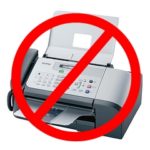Axe the Fax: Save Money and Lower Your Climate Footprint
April Compingbutra, MPH
It’s time to takes steps to abandon your fax machines. Your healthcare practice can reap large savings by ridding yourself of this outdated technology. With some simple steps, most offices anywhere in the world today can dramatically lower their fax burden, and some can eliminate it altogether.
by ridding yourself of this outdated technology. With some simple steps, most offices anywhere in the world today can dramatically lower their fax burden, and some can eliminate it altogether.
As of 2019, an overwhelming 90% of U.S. healthcare providers still relied on a fax (“facsimile”) machine despite these machines being inefficient and expensive.1 A busy office can send and receive 12,000 to 48,000 fax pages per year.1 One year’s faxes can mean consuming as much as a ton of wood to make the paper and releasing 4000 pounds of carbon dioxide as the result of burning fossil fuels to generate the needed electricity. This electricity could power 100 large refrigerators for an entire year!
Handling all this paper is tedious and time-consuming: collecting it from the tray, finding the proper patient file, storing or scanning the fax, uploading it to the electronic record, and destroying the paper fax. Even more stunning is that only 54% of faxed referrals result in scheduled appointments.
The costs are enormous. Each dedicated fax machine costs an average of $720 (U.S.) per year; a laser printing fax will cost even more, about 2-2.5 cents per page. Another estimate claims that an average medical office fax machine that is powered “on” for 8 hours a day, 5 days a week for 50 weeks in a year consumes 600 kWh of electricity and is responsible for producing 935 pounds of C02. That is enough energy to drive a gasoline car from Florida to New York City! 2,3
“Only 54% of faxed referrals result in scheduled appointments.”
In 2018, the U.S. Centers for Medicare and Medicaid Services (CMS) challenged the healthcare industry to eliminate this technology from a prior era. So where do you start?
The first step is to make environmental sustainability a goal for your clinic, office, or outpatient center. Set clear goals for sustainability and your climate change impact. Doing so will save money, create a healthier office, improve job satisfaction, decrease your greenhouse gas footprint, and may even enhance community health outcomes. An easy, free guide for this is My Green Doctor, an online practice management program used by thousands of health professionals. You begin by registering at MyGreenDoctor.org or at MyGreenDoctor.es (for Spanish), and by watching the three-minute video that explains how small improvements will over time add up to valuable benefits.
Next, let “Axing the Fax” be one of your first successful actions:
Get Organized
- Decide that your healthcare office, clinic, or facility will switch over time to online communication (electronic record, email, text, or instant messaging) for common communications such as record requests, messages for on-call providers, orders, and prescription refills.
 Pick a “Fax Server” software package for your practice to manage messages. Your electronic health record (EHR) may offer a fax server program or you can choose from one of the many HIPAA-compliant options. Examples include Zetafax, FaxCore, and InterFAX. Using one of these, an office staff member can easily sort incoming messages and records into the trash bin or to the proper person.
Pick a “Fax Server” software package for your practice to manage messages. Your electronic health record (EHR) may offer a fax server program or you can choose from one of the many HIPAA-compliant options. Examples include Zetafax, FaxCore, and InterFAX. Using one of these, an office staff member can easily sort incoming messages and records into the trash bin or to the proper person.- Set up a single email address for receiving documents, such as “[email protected]”. Tell your referring providers, hospitals, pharmacies, nursing homes, and vendors that you now receive documents, messages, and orders electronically by email rather than by fax.
Go Electronic
- Train your co-workers to send documents directly from their computer to other offices (“electronic faxing”) using fax server software and without using a printer or a fax machine.
- Use electronic filing. Ask your electronic health records (EHR) vendor how patient records that would have been faxed can instead go directly into your EHR. As with fax server software, a coworker will be assigned to view incoming documents on a computer and to file them electronically for the appropriate health professionals to review in the EHR.
- Interprofessional: Use a direct messaging system rather than faxes for professionals to communicate with each other. One study reported that nearly 49% of U.S. healthcare workers admitted they have read a fax intended for someone else due to the document being unattended at a physical fax machine.1 Direct messaging services are safer and faster than faxes, and likely to be compliant with the U.S. HIPAA standards, the European Union’s data protection rules, and the laws of your country.
- Make it the standard in your office to submit insurance claims electronically. Most government and private insurance companies will prefer this.
- If available, join a Health Information Exchange (HIE): An HIE is a single, secure online
 location to which health systems and practices send all of their clinical data. Authorized users can easily access records from different facilities and practitioners. The largest U.S. HIE, eHealth Exchange, is active in all 50 States, sharing records from hundreds of hospitals and large healthcare systems.4
location to which health systems and practices send all of their clinical data. Authorized users can easily access records from different facilities and practitioners. The largest U.S. HIE, eHealth Exchange, is active in all 50 States, sharing records from hundreds of hospitals and large healthcare systems.4
During Your Fax Machine’s Final Days
- Switch your fax machine settings to double-sided printing to save money.
- Send your unneeded fax machine to electronic recycling since some of its parts can be reused and others are toxic.
Now is the time to begin your transition from the fax machine into the 21st Century. Doing so will reduce your practice costs and increase workflow efficiency. Plus, you will use far less paper, reduce the physical space needed for storing files, and create a healthier environment for your community. Now is the time to axe your fax!
 April Compingbutra, MPH (she/her/hers) is a Public Health Analyst with Lantana Consulting Group. She has over 19 years of experience in federal government and international non-profit work. At Lantana, Ms. Compingbutra is a subject matter expert on a variety of federal projects providing expertise on hospital and physician office quality reporting, public reporting, and conducting education for government and industry stakeholders. [email protected]
April Compingbutra, MPH (she/her/hers) is a Public Health Analyst with Lantana Consulting Group. She has over 19 years of experience in federal government and international non-profit work. At Lantana, Ms. Compingbutra is a subject matter expert on a variety of federal projects providing expertise on hospital and physician office quality reporting, public reporting, and conducting education for government and industry stakeholders. [email protected]
About Lantana
The Lantana Consulting Group (https://www.lantanagroup.com/) is an environmentally minded firm that creates information services and software for healthcare. Some of their clients include the U.S. Centers for Disease Control, the Centers for Medicare and Medicaid Services, the National Institute of Health, professional societies, and commercial clients from start-ups to Fortune 100 companies. The greenLantana Team is reducing the environmental impact of IT systems and practices.
Hashtags @lantanagroup #fax #medtwitter #EHR #healthIT #paperless #interoperability
Sources
- Hold, David. Three Buried Costs of Your Company’s Legacy Fax Machines. 20 May 2019. https://enterprise.efax.com/blog/3-buried-costs-of-your-companys-legacy-fax-machines. Accessed 5 March 2021
- Wicklund, Eric. SecureCare gives doctors an option to manual faxes.
https://www.healthcareitnews.com/news/securecare-gives-doctors-option-manual-faxes. Accessed 18 February 2021.
- Environmental impact estimates used the Environmental Paper Network Paper Calculator Version 4.0. For more information visit papercalculator.org.
- Health Information Exchange Interoperability. https://www.ama-assn.org/practice-management/digital/health-information-exchange-interoperability. Accessed 5.25.21
Photo Sources
- gizmondo.com Accessed 5.28.2021
- https://japandaily.jp/are-fax-machines-inseparable-from-japanese-society-1629/ Accessed 5.28.21
- McGrath North Law firm www.mcgrathnorth.com Accessed 5.28.21


We hope you find our blog useful. Please send us your experience with this topic. Todd Sack
[email protected]—
Pingback: ≫ Ax the Fax: Ahorre dinero y reduzca su huella climática